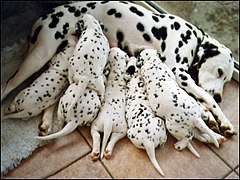Dog appeasing pheromone
Dog appeasing pheromone (DAP), sometimes known as apasine, is a mixture of esters of fatty acids released by the sebaceous glands in the inter-mammary sulcus of lactating female dogs. It is secreted from between three and four days after parturition and two to five days after weaning.[1] DAP is believed to be detected by the vomeronasal organ (Jacobson's organ)[1] and has an appeasing effect on both adults and pups,[1] and assists in establishing a bond with the mother.[2]

Synthetic DAP analogues have been developed which may support dogs during some, but not all, stressful situations.[3][3][4][5][6][7]
Synthetic analogue
Synthetic DAP analogues have been developed (e.g. "Adaptil"[7]), however, there is mixed evidence for the efficacy of synthetic DAP in reducing stress-related behaviours.[8][9]
Synthetic DAP can be effective at reducing stress-related behaviours in a number of contexts[10] including puppies enrolled in socialization classes.[11] A double-blind, placebo-controlled study found that newly adopted puppies aged 6 to 10 weeks cried less when exposed to synthetic DAP, but only in gun-dog breeds.[12] It has been found to be highly effective in fear behaviours relating to sound sensitivity and fear of noises (e.g. fireworks and thunder).[2]
Synthetic DAP is ineffective for dogs housed in long-term kenneling facilities[10] and does not reduce soiling behaviour in newly adopted puppies.[12]
In 2014, a critical review of studies on the use of synthetic DAP in veterinary hospital wards concluded that there was "little or no robust evidence" of it being effective in this environment.[7]
References
- Pageat, P.; Gaultier, E. (2003). "Current research in canine and feline pheromones". Veterinary Clinics of North America: Small Animal Practice. 33 (2): 187–221. doi:10.1016/s0195-5616(02)00128-6.
- Bowen, J.; Heath, S. (2005). Behaviour Problems in Small Animals: Practical Advice for the Veterinary Team. Elsevier Health Sciences. p. 58. ISBN 978-0702027673.
- VetSci (2011). "Dealing with canine anxiety and phobias". VetSci. Retrieved August 15, 2015.
- Tynes, V.V.; Sinn, L.; Koch, C.S. (2015). "Chapter 4 - The relationship between physiology and behavior in cats and dogs". In Emily Weiss; Heather Mohan-Gibbons; Stephen Zawistowski (eds.). Animal Behavior for Shelter Veterinarians and Staff. John Wiley and Sons. p. 94. ISBN 978-1-118-92283-5.
- Kim, Y.M.; Lee, J.K.; Abd El-aty, A.M.; Hwang, S.H.; Lee, J.H.; Lee, S.M. (2010). "Efficacy of dog-appeasing pheromone (DAP) for ameliorating separation-related behavioral signs in hospitalized dogs". The Canadian Veterinary Journal. 51 (4): 380–4. PMC 2839826. PMID 20592826.
- Gaultier, E.; Bonnafous, L.; Bougrat, L.; Lafont, C.; Pageat, P. (2005). "Comparison of the efficacy of a synthetic dog-appeasing pheromone with clomipramine for the treatment of separation-related disorders in dogs". Veterinary Record. 156 (17): 533–537. doi:10.1136/vr.156.17.533.
- Hewson, C. (2014). "Evidence-based approaches to reducing in-patient stress–Part 2: Synthetic pheromone preparations". Veterinary Nursing Journal. 29 (6): 204–206. doi:10.1111/vnj.12140.
- Miller, L.; Zawistowski, S. (2015). "Chapter 7 - Housing, husbandry and behavior of dogs in animal shelters". In Emily Weiss; Heather Mohan-Gibbons; Stephen Zawistowski (eds.). Animal Behavior for Shelter Veterinarians and Staff. John Wiley and Sons. p. 160. ISBN 978-1-118-92283-5.
- Frank, D.; Beauchamp, G.; Palestrini, C. (2010). "Systematic review of the use of pheromones for treatment of undesirable behavior in cats and dogs". Journal of the American Veterinary Medical Association. 236 (12): 1308–16. doi:10.2460/javma.236.12.1308. PMID 20550445.
- Grigg, E.K.; Piehler, M. (2015). "Influence of dog appeasing pheromone (DAP) on dogs housed in a long-term kennelling facility". Veterinary Record Open. 2 (1): e000098. doi:10.1136/vetreco-2014-000098. PMC 4567158. PMID 26392901.
- Denenberg, S.; Landsberg, G.M. (2008). "Effects of dog-appeasing pheromones on anxiety and fear in puppies during training and on long-term socialization". Journal of the American Veterinary Medical Association. 233 (12): 1874–1882. doi:10.2460/javma.233.12.1874. PMID 19072600.
- Taylor, K.; Mills, D.S. (2007). "A placebo-controlled study to investigate the effect of dog appeasing pheromone and other environmental and management factors on the reports of disturbance and house soiling during the night in recently adopted puppies (Canis familiaris)". Applied Animal Behaviour Science. 105 (4): 358–368. doi:10.1016/j.applanim.2006.11.003. Retrieved August 15, 2015.